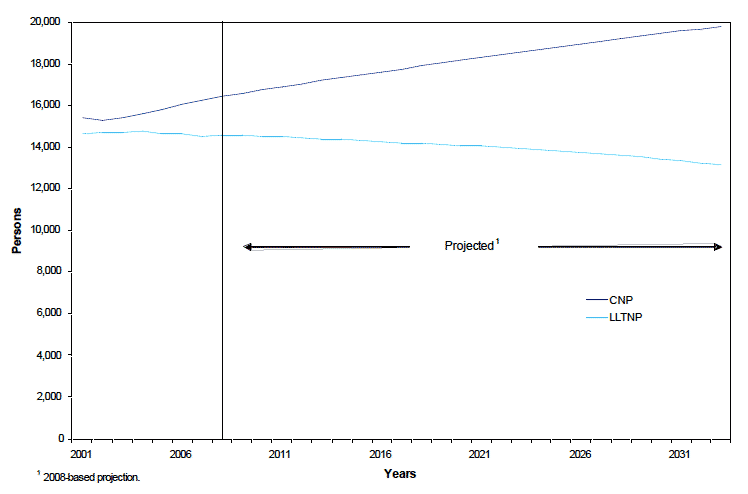
2.1 Main Points
The key points in this paper, relating to the National Parks, are:
Summary of percentage changes in population projected in National Parks and Scotland, 2008-2033
|
CNP |
LLTNP |
Scotland |
|---|---|---|---|
Population |
20% |
-10% |
7% |
Children (0-15) |
0% |
-25% |
-2% |
Working Age 1 |
16% |
-20% |
2% |
Pensionable Age 2 |
43% |
24% |
31% |
1 Working age is 16-59 for women and 16-64 for men until 2010. Between 2010 and 2020 working age becomes 16-64 for women. Between 2024 and 2026, working age for both men and women becomes 16-65 and changes again, in two further steps, to 16-67 by 2046.
2 Pensionable age is 65 for men and 60 for women until 2010. Between 2010 and 2020, the pensionable age for women increases to 65. Between 2024 and 2046, the pensionable age for both men and women increases to 66 and changes again, in two further steps, to 68 by 2046.
2.2 Total Population
2.2.1 The estimated population of the National Parks in the years 2001 to 2008, and the population projection for the years 2008 to 2033, is illustrated in Figure 1 and summarised in Table 1. The population of CNP is projected to increase by around 20 per cent from 16,430 in 2008 to 19,760 in 2033. The population of LLTNP is projected to decrease by 10 per cent, from 14,590 in 2008 to 13,140 in 2033.
Figure 1: Estimated and projected population of CNP and LLTNP, 2001-2033

2.3 Age Structure
2.3.1 Cairngorms National Park
2.3.1.1 Although the population of CNP is projected to rise between 2008 and 2033, the increase is not evenly distributed across all ages, as Figure 2 shows. The number of people aged 75 and over is projected to increase considerably - by 110 per cent. There is an increase of over a third in the population aged 60-74, and smaller increases in the population age groups under 60 (ranging from less than 1 per cent to 6 per cent).
Figure 2: Projected percentage change in population, by age group, CNP, 2008-2033
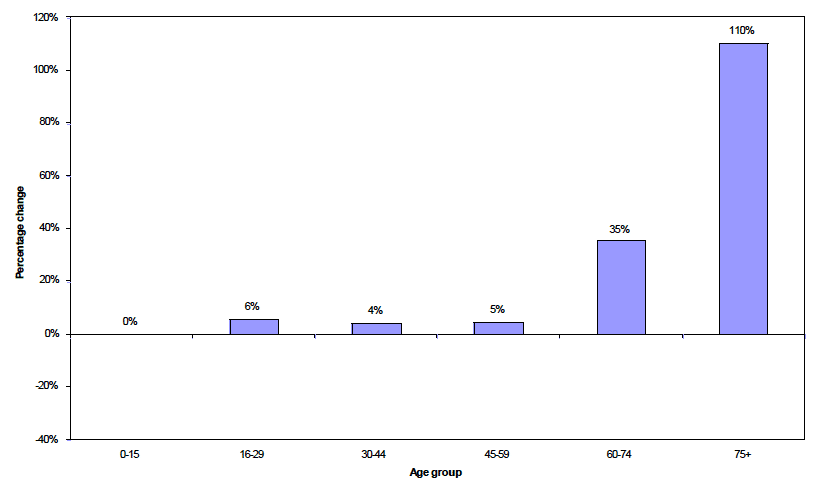
2.3.1.2 Figure 3 illustrates the changing age structure of CNP. In 2008 there was a small peak of children and a larger peak of people between ages 40 and 65. Due to the projected increase in the population of older age, by 2033 the population is projected to be more evenly distributed across all ages, except for a large increase in the population aged 90 and over.
Figure 3: Estimated and projected population, by age and sex in CNP, 2008 and 2033
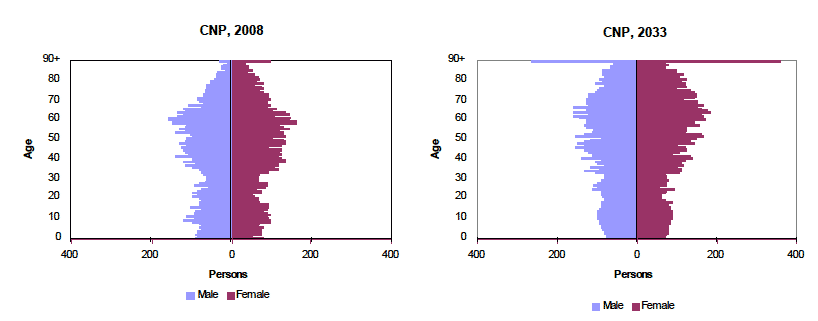
2.3.1.3 Table 2a summarises the changing age structure. For CNP the number of children under 16 is projected to remain fairly constant, at around 2,730. A 16 per cent increase is projected for people of working age, from 9,610 in 2008 to 11,180 in 2033. The largest increase is for people of pensionable age. This age group is projected to increase by 43 per cent from 4,090 in 2008 to 5,850 in 2033.
2.3.1.4 The figures in Table 2a take into account changes in the state pension age which will increase from 60 to 65 for women between 2010 and 2020, and then from 65 to 66 for both sexes between 2024 and 2026. There are no further changes in the state pension age until 2034.
2.3.1.5 Projected populations for CNP, by sex and five year age groups, are given in Table 3a.
2.3.2 Loch Lomond and the Trossachs National Park
2.3.2.1 As shown in Figure 4, all age groups except 75 and over in LLTNP are projected to decrease by 2033. The number of people of 75 and over is projected to increase by 110 per cent, which is similar to CNP. For LLTNP the population aged 16-29 is the age group projected to decrease the most (38 per cent). The number of children aged under 16 is projected to decrease by 25 per cent. The 30-44, 45- 59 and 60-74 age groups are also projected to decrease by 18, 28, and 2 per cent respectively.
Figure 4: Projected percentage change in population, by age group, LLTNP, 2008-2033
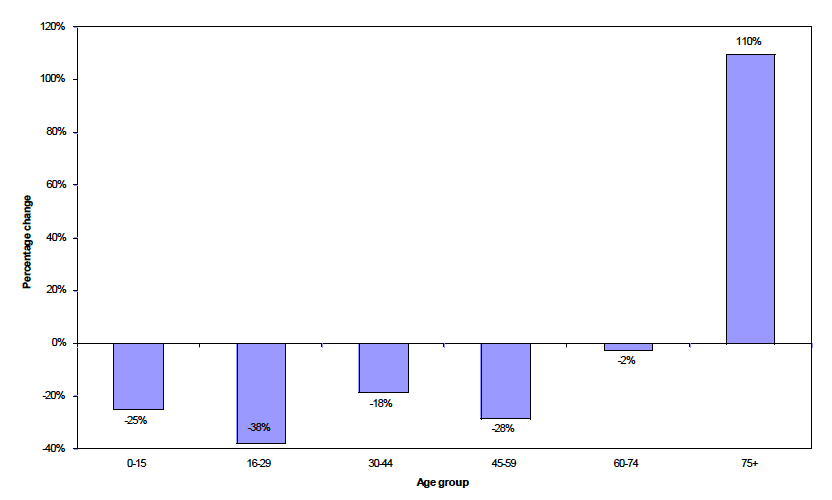
2.3.2.2 Figure 5 highlights the changing age structure of LLTNP. In 2008 there are peaks in the teenage population and the population aged 40 to 60. By 2033 the age structure looks top-heavy, with the largest group aged 90 and over. This is due to large decreases in the population aged under 30, and an increase in the elderly population.
Figure 5: Estimated and projected population, by age and sex in LLTNP, 2008 and 2033
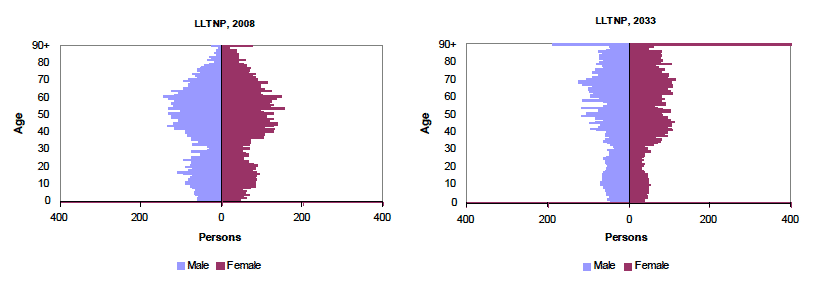
2.3.2.3 Table 2b shows that there is projected to be a 25 per cent decrease in children in LLTNP, from 2,220 in 2008 to 1,660 in 2033. The population of working age is also projected to decrease (by 20 per cent) from 8,760 to 6,990. The population of pensionable age is projected to increase by 24 per cent from 3,610 to 4,490 by 2033, due mainly to the ageing of the existing population in 2008.
2.3.2.4 The figures in Table 2b take into account changes in the state pension age which will increase from 60 to 65 for women between 2010 and 2020, and then from 65 to 66 for both sexes between 2024 and 2026. There are no further changes in the state pension age until 2034.
2.3.2.5 Projected populations by sex and five year age groups for LLTNP are shown in Table 3b.
2.4 Components of population change
2.4.1 Cairngorms National Park
2.4.1.1 Table 4a shows projected net migration and natural change (births minus deaths) in CNP between 2008 and 2033. The number of deaths is projected to continue to exceed the number of births (giving negative natural change), and the gap between births and deaths is projected to increase from 40 per year to 100 per year over the projection period. This is due to a rise in the number of deaths (because of the ageing population) whilst births remain fairly constant.
2.4.1.2 A net inflow of 200 migrants per year is likely. This exceeds the negative natural change and accounts for the increase in the total population in CNP between 2008 and 2033.
2.4.2 Loch Lomond and Trossachs National Park
2.4.2.1 Table 4b shows that in LLTNP deaths are projected to exceed births (negative natural change) throughout the period 2008 to 2033. The gap between births and deaths increases from 30 per year to 110 per year during the 25 year projection period.
2.4.2.2 Over the projection period, net migration is assumed to be zero. With the decrease in births and increase in deaths, this leads to a projected decrease of 1,450 (10 per cent) in the population of LLTNP between 2008 and 2033.